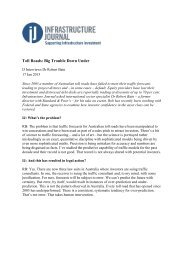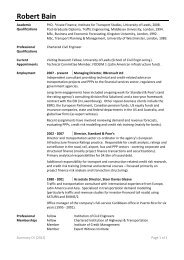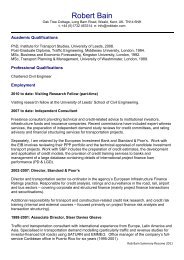Disincentivising overbidding for toll road concessions
Disincentivising overbidding for toll road concessions
Disincentivising overbidding for toll road concessions
- No tags were found...
You also want an ePaper? Increase the reach of your titles
YUMPU automatically turns print PDFs into web optimized ePapers that Google loves.
5 │ CONCLUSIONS<br />
5.1 Best-practice principles<br />
In this section, problems and solutions are considered in each of the five distinct stages in the <strong>concessions</strong> process<br />
introduced in section 2.3 (and reproduced in Figure 5.2). Across each procurement stage, greater consideration<br />
needs to be given to incentive compatibility and incentive alignment within bidding consortia.<br />
Figure 5.2 Stages in the <strong>concessions</strong> process<br />
Pre-procurement<br />
How is this project<br />
justified<br />
Concession design<br />
What are parties<br />
bidding <strong>for</strong><br />
Bidding process<br />
How is bidding<br />
organised<br />
Bid Appraisal<br />
What criteria are<br />
bids judged against<br />
Post-contract award<br />
What happens<br />
after the contract<br />
is awards<br />
••<br />
public sector<br />
optimism<br />
and strategic<br />
<strong>for</strong>ecasting<br />
••<br />
political<br />
pressures<br />
Source: Oxera<br />
••<br />
risk transfer ••<br />
private sector<br />
optimism bias<br />
••<br />
strategic bidding<br />
••<br />
structure of bid<br />
teams<br />
••<br />
winner’s curse<br />
••<br />
objective:<br />
revenue<br />
maximisation or<br />
efficient use of<br />
resource<br />
••<br />
incentive<br />
compatibility<br />
••<br />
technical errors<br />
••<br />
renegotiation<br />
5.1.1 Pre-procurement phase<br />
In considering <strong>overbidding</strong>, it is important to look at how the decision to carry out the project was originally reached.<br />
Politicians may be biased towards the short term in their decision-making since they are likely to be seen positively <strong>for</strong><br />
getting a project ‘off the ground’ and are likely to have left office by the time the project runs into any problems. The<br />
public sector may there<strong>for</strong>e face incentives to drive up demand or revenue <strong>for</strong>ecasts in order to get the go-ahead <strong>for</strong> a<br />
project. This can result in public sector comparator figures that are unrealistically high.<br />
Consequently, it is important to ensure that political pressure does not push up demand expectations (and feed<br />
into an unrealistic public sector comparator) in the pre-procurement phase. The UK government has looked to<br />
overcome this problem through its VfM model, which requires that projects are assessed against strategic, economic,<br />
commercial, financial and management criteria; and that they receive sign-off from a senior civil servant (in the <strong>for</strong>m<br />
of the department’s permanent secretary).<br />
Key principle<br />
Further consideration is needed about how political pressures to produce over-optimistic <strong>for</strong>ecasts can be<br />
reduced, and how to ensure that projects are undertaken only where they are commercially and economically<br />
viable.<br />
61






